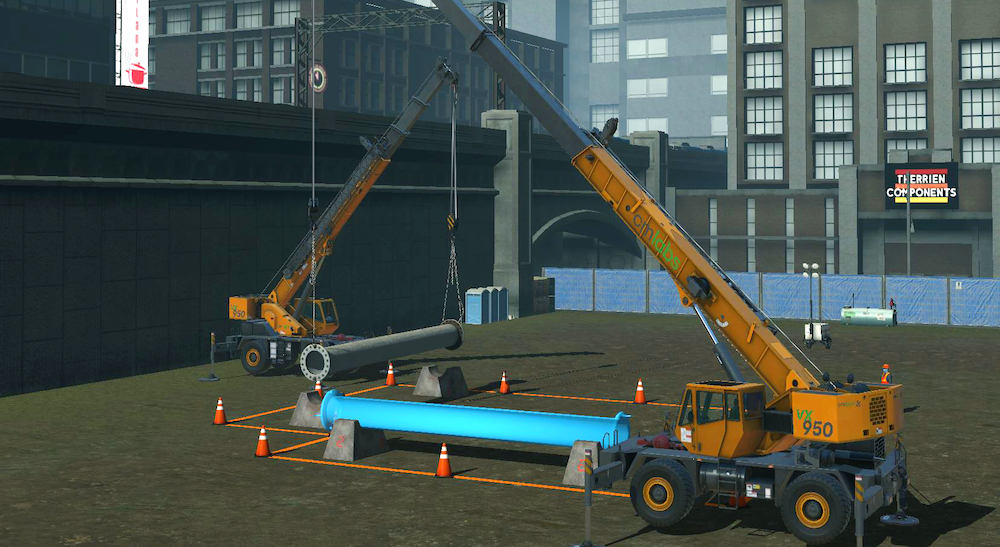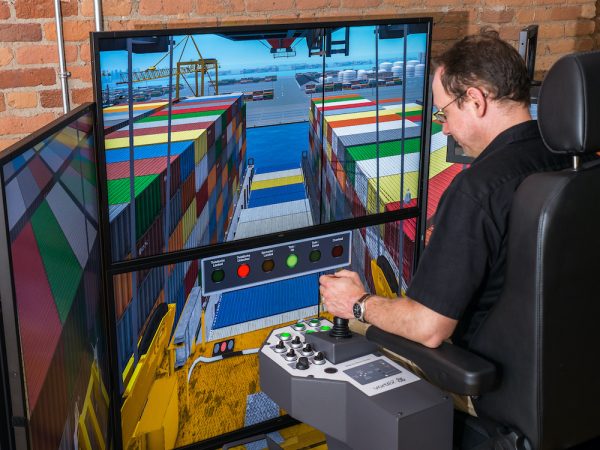
Features
Education & Training
Manipulating machines: Using simulation to train crane operators
Simulation is becoming an important recruitment tool for the construction industry
October 8, 2021 By Crane & Hoist Canada Staff
 Mobile crane simulation. Photo: CM Labs
Mobile crane simulation. Photo: CM Labs Simulation technology can be used to help the construction industry grow.
In a panel hosted earlier this year by CM Labs Simulations, Debbie Dickinson, CEO of Crane Industry Services (CIS), joined Dan Belcher, director of strategic partnerships at the U.S.-based National Center for Construction Education and Research (NCCER), and moderator Drew Carruthers, former director of product management and strategic partnerships at CM Labs Simulations, to talk about workforce development.
The discussion covered how equipment simulators can be used for recruiting people to the industry, and by companies to retain and grow the skills of their current workforce.
“We are now seeing a resurgence of career and technical education (CTE),” said Belcher. “The idea that individuals have to go to a four-year college to be successful, or continue on a formalized education route, is slowly changing.”
Belcher believes that attracting the next generation into the skilled trades requires the industry to get involved with students, parents and educators. He adds that industry needs to align with educators to provide direction on the skill sets that are in demand, and to give context to the learning that happens at both the secondary and post-secondary level.
“It is also important to discuss the career pathways for students in high school and college,” he said.
‘Gamification’ for the younger generation
Simulators are a great way to engage with the next generation, because today’s students don’t know a world without technology. “If a static picture is worth a thousand words, an interactive simulator turns lights on,” Dickinson said.
Belcher said the construction industry must showcase how technologically advanced it is in order to win over young people. “We’re competing against IT, cybersecurity, all of the STEM programs,” he said. Students need to know that “science, technology, engineering, and mathematics are used every day on construction sites. You walk on a jobsite and you will not see a physical set of blueprints anymore.”

Photo: CM Labs
Using simulation as a training tool
Carruthers noted that “recruiting will always be important, but research is showing that investing in training increases productivity. Employers should have an equal focus on upgrading and upscaling their existing employees.”
Providing individuals who are welders or labourers with an opportunity to become equipment operators is an investment in the individual and the workforce, he said.
Simulation is one way to appeal to younger workers and upskill your existing workforce. Crane & Hoist Canada followed up with Mala Dewan, construction and forestry product marketing manager at CM Labs, to get more insight into how simulators work for the heavy lifting industry.
Crane & Hoist Canada: What are the benefits of simulation technology for the heavy lifting industry?
Mala Dewan: The major benefit of simulation is providing a safe and controlled environment in which operators can learn and upskill. It’s also a great tool to evaluate competency and store records of proof of competency.
It allows even experienced operators to prepare for more complex operations, like tandem lifts. Employers can use simulation to benchmark their most productive operators and use those benchmarks budget more accurately.
What movements can be simulated on a crane?
MD: We can accurately replicate crane boom and jib bending/torqueing, stability and overloading/overturning risks, cable collisions with worksite obstructions and the crane boom, and pendulums, snags, and collisions.
Operators really learn how to manipulate the machine and gain a deep understanding of the consequences of their actions.
How does simulation work to change the learning process in the brain during training?
MD: Simulation helps build muscle memory for exercises that go beyond just basic control familiarization. Operators learn how to handle themselves in complex situations and weather conditions so there are no surprises when they reach the worksite. You can simulate everything from wind speed to weather and inject faults.
Clients have indicated that simulation improves trainee confidence so they are more prepared to get behind the controls of the real machine.
Are crane operators more likely to retain information using a training simulator?
MD: Research shows that repetition improves retention and that is one of the major benefits of simulation. With hands-on training, exposure to a variety of complex scenarios is often limited. Operators oftentimes train during the project at hand but once the job is complete, it cannot be redone. With simulation, you can repeat a blind lift or a tandem lift several times until you’ve achieved an optimal score.
That said, there is a misconception that simulation is meant to replace hands-on training, but we don’t advocate that. Simulation is meant to bridge the gap from the classroom to the worksite and help expose operators to more exercises and seat time before getting on the real equipment. Simulation is meant to supplement classroom learning and complement hands-on training.
What types of simulation does CM Labs use for training in the crane industry?
MD: We offer three hardware solutions. One is the portable desktop Vortex Edge Plus – portability and ease of setup allows you to train, recruit and assess anywhere. It’s built on the same high-fidelity software (CM Labs’ Smart Training Technology) that powers the motion-enabled, more immersive solutions so machine behaviour/reaction is just as real.
Second, the motion-enabled Vortex Edge Max is easy to transport, set up, and use. Wheel the Vortex Edge Max out of the shipping crate and get up and running in under 10 minutes.
Last, the highly immersive multi-display Vortex Advantage is available with three or five screens. It features equipment-specific hot-swappable control sets and pedals. The three-screen option also rotates to replicate equipment-specific sight lines.
These solutions allow organizations to scale. They can start on an Edge Plus then move onto the Edge Max and Advantage. They can even pair simulators to execute crew training exercises like the tandem lift.
What are some of the exercises that trainees can do on the simulator?
MD: Exercises go from basic to advanced and include LMI configuration and alarms, hook and load management and pendulum control, unloading materials on the worksite, moving loads within the building site, working inside a building, changing part of a line with pulley block, practicing CCO test courses, skills assessment, complex lifts in confined spaces, tandem lifts and blind lifts.
What technology does a simulator use to mimic machine behaviour?
MD: CM Labs’ Vortex Simulators are uniquely powered by our Smart Training Technology. This results in simulations that have been engineered through careful modelling and reproduction of real machine data. From hydraulics systems, to engine behaviour and machine sounds, the accuracy is backed by more than 20,000 automated daily tests, ongoing research and development.
Through Smart Training Technology, Vortex simulators capture the relationship between all machine parts to ensure that the reactions mirror those of the actual equipment. All of which has been field-tested by subject matter experts like operating engineers and major OEMs. This ultimately means that every simulated machine delivers transferable skills that trainees take to the job site.
How can an employer feel confident that a trainee using a simulator is ready to be in the field?
MD: The simulators capture operating metrics for continual and comprehensive scoring and reporting on a trainee’s progress. Metrics that contribute to a final score can be customized – instructors can weight each metric, provide thresholds and deduct points for issues like collisions, human contact or exceeding time limits.
Instructors can also use our Instructor Operating Station (IOS) to initiate exercise sessions, monitor operations from their own independent work station, and challenge trainees by exposing them to a wide range of tasks and job site conditions.
The IOS also provides instructors with a real-time 3D view of learning progress, from any vantage point on the virtual work site. The scoring and reporting feature is what allows employers to feel confident their operators are ready for the real thing.
Print this page